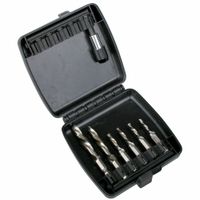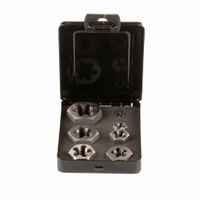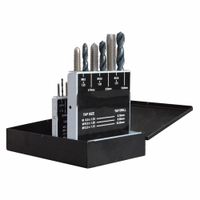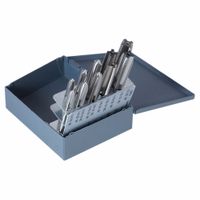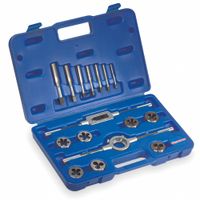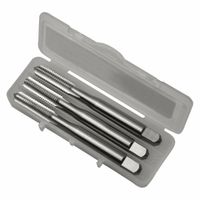Call +(254) 703 030 000 / 751 483 999 / 721 704 777
.....Read More
Frequently Asked Questions
What is a tap and die set used for?
A tap and die set is a collection of tools used to create screw threads, which are essential for fastening components together in various mechanical and construction applications. The set typically includes taps, dies, and often additional accessories like wrenches and handles.
Taps are used to cut or form the female portion of the mating pair, known as the nut or the internal thread. They are inserted into a pre-drilled hole and rotated to cut threads into the material, allowing a bolt or screw to be inserted. Taps come in different types, such as taper, plug, and bottoming taps, each designed for specific threading tasks and materials.
Dies, on the other hand, are used to cut or form the male portion of the mating pair, known as the bolt or the external thread. They are typically circular and are used to cut threads on cylindrical rods, creating bolts or threaded shafts. Dies can be adjustable or fixed, with adjustable dies allowing for slight variations in thread diameter.
A tap and die set is essential for repairing damaged threads, creating new threads, or cleaning up existing threads. It is widely used in automotive repair, plumbing, metalworking, and DIY projects. The set allows for precise and consistent thread creation, ensuring that components fit together securely and function properly.
Overall, a tap and die set is a versatile and indispensable tool for anyone working with threaded fasteners, providing the ability to create and repair threads with accuracy and efficiency.
How do you use a tap and die set?
To use a tap and die set, follow these steps:
1. **Select the Tap or Die**: Choose the appropriate size and type of tap or die for the thread you need. Taps are used for internal threads, while dies are for external threads.
2. **Prepare the Material**: Ensure the material is suitable for threading. For tapping, drill a hole slightly smaller than the tap size. For dies, ensure the rod or bolt is slightly smaller than the die size.
3. **Secure the Workpiece**: Clamp the workpiece in a vise to prevent movement during threading.
4. **Lubricate**: Apply cutting oil to the tap or die and the workpiece to reduce friction and prevent damage.
5. **Using a Tap**:
- Insert the tap into a tap wrench.
- Align the tap with the hole and turn it clockwise to start threading.
- Apply gentle pressure and ensure the tap is perpendicular to the surface.
- Turn the tap a full turn forward, then a half turn back to clear chips.
- Continue until the desired depth is reached.
6. **Using a Die**:
- Place the die in a die stock.
- Align the die with the rod or bolt and start threading by turning clockwise.
- Ensure the die is perpendicular to the rod.
- Turn the die a full turn forward, then a half turn back to clear chips.
- Continue until the desired length of thread is achieved.
7. **Clean and Finish**: Remove the tap or die, clean the threads with a brush, and inspect for accuracy. Deburr any sharp edges if necessary.
8. **Safety**: Always wear safety goggles and gloves to protect against metal shavings and sharp edges.
What are the different types of taps and dies?
Taps and dies are tools used to create screw threads, which are essential for fastening components. There are several types of taps and dies, each designed for specific applications:
**Taps:**
1. **Hand Taps:**
- **Taper Tap:** Has a gradual taper to ease the cutting process, ideal for starting threads.
- **Plug Tap:** Has a less pronounced taper, used after the taper tap to deepen threads.
- **Bottoming Tap:** Has almost no taper, used to cut threads to the bottom of a blind hole.
2. **Machine Taps:**
- **Spiral Point Tap:** Features a spiral point that pushes chips ahead, suitable for through holes.
- **Spiral Flute Tap:** Has spiral flutes to pull chips out, ideal for blind holes.
- **Forming Tap:** Displaces material to form threads without cutting, used for ductile materials.
3. **Specialty Taps:**
- **Pipe Tap:** Used for creating threads in pipes, available in taper and straight forms.
- **Acme Tap:** Designed for Acme threads, used in power transmission applications.
**Dies:**
1. **Solid Dies:**
- **Round Die:** Commonly used for threading rods, available in adjustable and fixed types.
- **Hex Die:** Used for rethreading damaged threads, easily turned with a wrench.
2. **Adjustable Dies:**
- Allow for minor adjustments in thread diameter, providing flexibility in thread fit.
3. **Specialty Dies:**
- **Pipe Die:** Used for threading pipes, matching pipe tap threads.
- **Acme Die:** Used for cutting Acme threads, complementing Acme taps.
These tools are essential in manufacturing, repair, and maintenance, providing precision and reliability in creating and repairing threaded connections.
How do you choose the right size tap and die?
To choose the right size tap and die, follow these steps:
1. **Determine the Thread Type**: Identify whether you need metric or imperial threads. This depends on the specifications of the project or the existing threads you are working with.
2. **Measure the Diameter**: Use a caliper or micrometer to measure the diameter of the bolt or rod for which you need a die, or the hole for which you need a tap. For metric threads, this is measured in millimeters, and for imperial threads, in inches.
3. **Identify the Thread Pitch**: For metric threads, measure the distance between threads in millimeters. For imperial threads, count the number of threads per inch (TPI). Use a thread pitch gauge for accuracy.
4. **Consult a Tap and Die Chart**: Use a chart to match the diameter and thread pitch to the correct tap and die size. These charts are available online or with tap and die sets.
5. **Select the Tap Type**: Choose between taper, plug, or bottoming taps based on the depth and type of hole. Taper taps are for starting threads, plug taps for through holes, and bottoming taps for blind holes.
6. **Select the Die Type**: Choose between adjustable or solid dies. Adjustable dies allow for slight variations in thread fit, while solid dies are fixed.
7. **Consider Material**: Ensure the tap and die material is suitable for the material you are threading. High-speed steel is common for general use, while cobalt or carbide is better for harder materials.
8. **Test Fit**: Before proceeding, test the tap and die on a scrap piece to ensure the fit and function are correct.
By following these steps, you can accurately select the right size tap and die for your threading needs.
What materials can taps and dies work on?
Taps and dies are versatile tools used for cutting threads in various materials. They can work on a wide range of materials, each requiring specific considerations to ensure effective threading.
1. **Metals**: Taps and dies are commonly used on metals such as steel, aluminum, brass, copper, and cast iron. High-speed steel (HSS) taps and dies are suitable for most metals, while cobalt or carbide tools are preferred for harder metals like stainless steel or titanium due to their increased durability and heat resistance.
2. **Plastics**: Taps and dies can be used on plastics like PVC, acrylic, and nylon. When working with plastics, it's important to use sharp tools and apply minimal pressure to prevent cracking or melting. Specialized taps with a high helix angle can help clear chips effectively.
3. **Wood**: Although less common, taps and dies can be used on wood, particularly hardwoods. The process requires careful handling to avoid splitting the wood. Coarse-thread taps are generally more effective for wood applications.
4. **Composites**: Materials like fiberglass and carbon fiber can be threaded using taps and dies, but they require tools with specific coatings or geometries to handle the abrasive nature of these materials. Carbide taps are often recommended for their wear resistance.
5. **Soft Materials**: Taps and dies can also work on softer materials like lead or zinc. These materials require less force and can be threaded with standard tools, but care must be taken to avoid deforming the threads.
In all cases, using the appropriate lubricant can reduce friction and heat, prolonging tool life and improving thread quality. Proper tool selection, speed, and feed rates are crucial to achieving optimal results across different materials.
How do you maintain and care for a tap and die set?
To maintain and care for a tap and die set, follow these steps:
1. **Cleaning**: After each use, clean the taps and dies thoroughly to remove metal shavings and debris. Use a stiff brush and compressed air to ensure all particles are removed.
2. **Lubrication**: Apply a light coat of machine oil to the taps and dies to prevent rust and corrosion. This also ensures smooth operation during use.
3. **Storage**: Store the set in a dry, cool place. Use the original case or a dedicated tool organizer to keep each piece in its designated spot, preventing damage and loss.
4. **Inspection**: Regularly inspect the tools for wear and damage. Check for dullness, chips, or cracks. Replace any damaged pieces to maintain the set's effectiveness.
5. **Sharpening**: If taps or dies become dull, have them professionally sharpened. Avoid using them when dull, as this can damage both the tool and the workpiece.
6. **Proper Use**: Always use the correct size tap or die for the job. Apply appropriate cutting fluid to reduce friction and heat. Use steady, even pressure to avoid breaking the tools.
7. **Avoid Over-Tightening**: When using a tap, avoid over-tightening, which can cause breakage. Turn the tap slowly and back it out periodically to clear chips.
8. **Environmental Protection**: Keep the set away from moisture and corrosive environments. Use silica gel packs in the storage case to absorb moisture.
9. **Training**: Ensure that anyone using the set is properly trained in its use and maintenance to prevent misuse and damage.
By following these steps, you can extend the life of your tap and die set and ensure it remains in optimal working condition.
What are the best brands for tap and die sets?
Some of the best brands for tap and die sets, known for their quality, durability, and precision, include:
1. **Irwin Tools**: Known for their high-speed steel construction, Irwin tap and die sets are durable and suitable for a variety of materials. They offer a range of sets for both professional and DIY use.
2. **GearWrench**: GearWrench sets are praised for their innovative designs and ease of use. They often include ratcheting T-wrenches and are made from high-quality materials, making them a favorite among mechanics.
3. **TEKTON**: TEKTON offers affordable yet reliable tap and die sets. They are known for their precise threading and are a good choice for both professionals and hobbyists.
4. **Hanson**: A sub-brand of Irwin, Hanson tap and die sets are known for their precision and durability. They are often used in professional settings and are made from high-carbon steel.
5. **Craftsman**: A well-known brand in the tool industry, Craftsman provides tap and die sets that are durable and reliable. They offer a lifetime warranty on many of their products, ensuring long-term use.
6. **Bosch**: Bosch tap and die sets are known for their engineering excellence and precision. They are often used in industrial settings and are made from high-quality materials.
7. **Greenfield Industries**: Known for their industrial-grade tools, Greenfield offers tap and die sets that are durable and precise, suitable for heavy-duty applications.
8. **Neiko**: Neiko provides budget-friendly options without compromising on quality. Their sets are suitable for light to medium-duty tasks and are popular among DIY enthusiasts.
These brands are recognized for their commitment to quality and innovation, making them reliable choices for both professional and home use.
